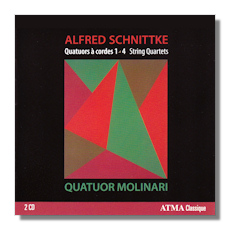
The Internet's Premier Classical Music Source
Related Links
- Schnittke Reviews
- Latest Reviews
- More Reviews
-
By Composer
-
Collections
DVD & Blu-ray
Books
Concert Reviews
Articles/Interviews
Software
Audio
Search Amazon
Recommended Links
Site News
 CD Review
CD Review
Alfred Schnittke

String Quartets
- Quartet #1
- Quartet #2
- Quartet #3
- Quartet #4
- Canon in Memoriam Igor Stravinsky
Quatuor Molinari
Atma Classique ACD2-2634 2CDs
Like many of Schnittke's roughly 250 compositions, his four string quartets reflect the influence of other composers. At times they also seem to obey the composer's dictum of "acting as though [conventional musical systems] do not exist". Such a compositional approach allows him effectively to subvert both the grip which other styles can exert on a free-thinking composer; and – paradoxically – to embrace a multitude of compositional genres and techniques… his famed "polystylism".
In the first movement, the first moments indeed, of the third quartet (the order on these CDs is 3, 1, 2, 4) from 1983 we identify Beethoven, Lassus and Shostakovich. This is no pastiche, of course. Rather the result of a true process of reflection and refinement. But it needs a sensitive ensemble to respect the delicacy of the amalgam. The Canadian Molinaris have just that sensitivity. Specialists in contemporary repertoire (the earliest composer whom they routinely perform is Ravel), their style nicely balances tentativeness (as the opposite of bluster, or bombast; but lacking nothing in confidence and commitment) with assertiveness and an ability to adapt to the twists and turns which Schnittke makes in these enigmatic, though very beautiful, quartets.
For every dissonant passage there is a harmonically grounded one; for every race a slumber. Significantly, for every reflection of the past, Schnittke also looks into the future. Into a future, indeed, as bleak and hopeless of anything the other great twentieth century writer in the medium, Shostakovich, ever achieved. Though Schnittke's style is, if anything, even harsher. Certainly more fragmented. The second movement, the Canon, of the first quartet [CD.1 tr.5], which dates from the mid 1960s, is a good example. Cleanly dodecaphonic and peppered with what we now call "extended techniques", it picks up the lessons of the second Viennese school and its heirs and most certainly makes them Schnittke's own. The persistent melodic disjoints owe more to Bartòk than to the great spirit of experimentation that was abroad in 1967 when the work was first performed. The Molinaris have the right blend of caution and respect for wherever Schnittke wants to lead the listener. They also convey with certainty the structure and the outcome, without which the three movements played continuously must have in order to make any sense at all.
The second quartet dates from 1980 and is the reaction to the death of Schnittke's friend, the filmmaker Larissa Efimovna Chepitko. It is redolent, both in the alternation of slow-fast movements and extreme dynamics as well as in the melodic material, of a liturgical funeral piece. It's perhaps the most striking of the four quartets at first hearing. The Quatuor Molinari, though, have so well absorbed its idiom and import and so deeply understood its need to keep moving, to occupy a position perfectly poised between reflection, allusion and strident novelty that their performance bears repeated listening in ways that would not be possible had they accentuated merely the potential for shock and the spectacle that also exists in many passages of this quartet.
The fourth quartet on the second CD along with the Canon in Memoriam Igor Stravinsky is almost twice as long at 38 minutes as the other three, each around 20 minutes. It's in five substantial movements, contrapuntal in flavor and slow in mood (no fewer than three of the five are actually marked lento). It's as lyrical as Berg was and energetic as was Webern. In many ways it sums up Schnittke's excursions in the medium. And into the worlds in which he lived with his poor health and despair at the brutality and ignorance which humans seem intent on practicing. The Molinari players have a majestic command of Schnittke's use of strings, his tortured melodic structure and sense of imminent doom. Without overplaying the place of the fourth quartet as a summation of what he had previously written, they nevertheless make a very compelling case for this work, full of pity and loss, as typifying the best of Schnittke.
This is a highly successful pair of CDs then. The liner notes are to the point and informative. The acoustic is close and helpful without being clinging. Technically the Molinari's playing is a good combination of the spontaneous and the obviously accomplished… listen to the quadruple pianos at the end of the second [CD.1. tr.10], for instance. No collector either of Schnittke or indeed of the twentieth century chamber music repertoire should let it bypass them. Both the Kronos (on Nonesuch 79500) and Tale (on BIS 467) have recorded cycles; although the latter lacks the fourth: the Alban Berg String Quartet (on EMI 54660, paired with Rihm's fourth) can be considered. The Quatuor Molinari have winning performances, full of depth, insight and a real understanding of Schnittke's emotional compass without for a moment descending into self-pity or false defiance. They truly do play Schnittke's most intimate and to be coveted music as though few other conventions exist. Surely what the composer would have wanted.
Copyright © 2011, Mark Sealey.





















